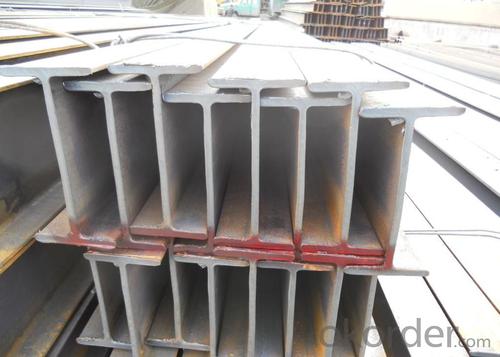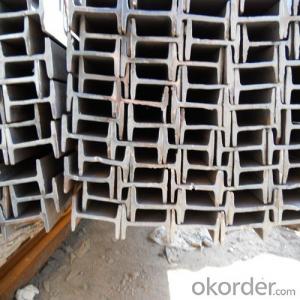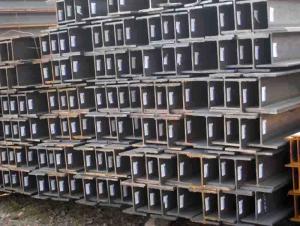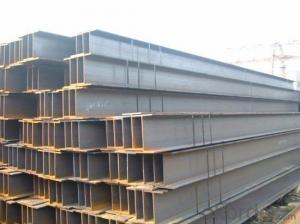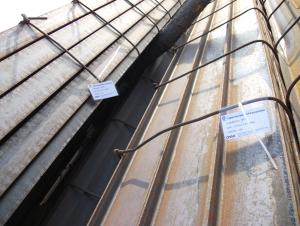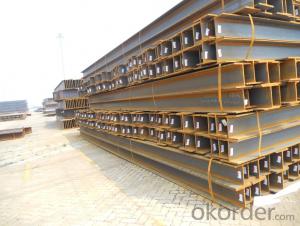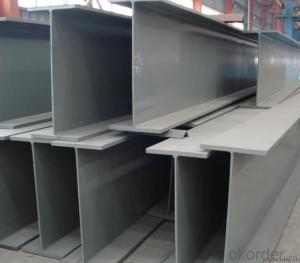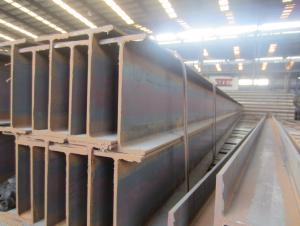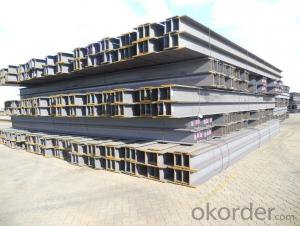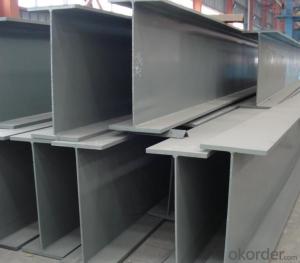Hot Rolled Steel Wide Flange H Beam
- Loading Port:
- China Main Port
- Payment Terms:
- TT or LC
- Min Order Qty:
- 100MT m.t.
- Supply Capability:
- 10000MT/month m.t./month
OKorder Service Pledge
OKorder Financial Service
You Might Also Like
Specifications of Hot Rolled Steel Wide Flange H Beam
1. Standard: JIS G3101, SS400(1987),GB700-88, Q235B,EN10034-1993 / EN10025-2004,
HEA100-HEA500,HEB100-HEB500
2. Grade: Q235, SS400 or Equivalent
3. Length: 6m,10m, 12m as following table
4. Invoicing on theoretical weight or actual weight as customer request
5.Payment: TT or L/C
6. Sizes:
SIZE(mm) | DIMENSION(kg/m) |
100*100 | 16.9 |
125*125 | 23.6 |
150*75 | 14 |
150*150 | 31.1 |
148*100 | 20.7 |
198*99 | 17.8 |
200*100 | 20.9 |
248*124 | 25.1 |
250*125 | 29 |
300*150 | 36.7 |
298*149 | 32 |
200*200 | 49.9 |
294*200 | 55.8 |
346*174 | 41.2 |
350*175 | 49.4 |
244*175 | 43.6 |
175*175 | 40.4 |
294*200 | 55.8 |
298*201 | 64.4 |
346*174 | 41.2 |
350*175 | 49.4 |
400*200 | 65.4 |
396*199 | 56.1 |
450*200 | 74.9 |
446*199 | 65.1 |
340*250 | 78.1 |
500*200 | 88.1 |
300*150 | 36.7 |
Usage & Applications of Specifications of Hot Rolled Steel Wide Flange H Beam
Commercial building structure ;Pre-engineered buildings; Machinery support structure; Prefabricated structure; Medium scale bridges; Ship-building structure. etc.
Packaging & Delivery of Hot Rolled Steel Wide Flange H Beam
1. Packing: it is nude packed in bundles by steel wire rod
2. Bundle weight: not more than 3.5MT for bulk vessel; less than 3 MT for container load
3. Marks:
Color marking: There will be color marking on both end of the bundle for the cargo delivered by bulk vessel. That makes it easily to distinguish at the destination port.
Tag mark: there will be tag mark tied up on the bundles. The information usually including supplier logo and name, product name, made in China, shipping marks and other information request by the customer.
If loading by container the marking is not needed, but we will prepare it as customer request.
4. Transportation: the goods are delivered by truck from mill to loading port, the maximum quantity can be loaded is around 40MTs by each truck. If the order quantity cannot reach the full truck loaded, the transportation cost per ton will be little higher than full load.
5. Delivered by container or bulk vessel
Production flow of Hot Rolled Steel Wide Flange H Beam
Material prepare (billet) —heat up—rough rolling—precision rolling—cooling—packing—storage and transportation

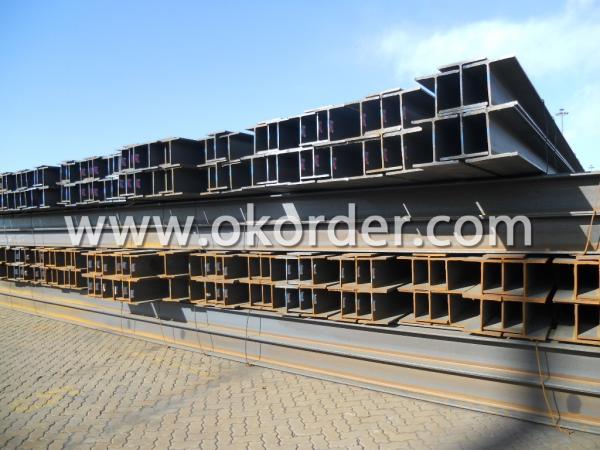
- Q: What are the different grades of Steel H-Beams available?
- The different grades of Steel H-Beams available depend on the specific requirements and standards set by different steel manufacturers and industry organizations. Some common grades include ASTM A36, ASTM A572, ASTM A992, and ASTM A588. These grades have varying mechanical properties, such as yield strength, tensile strength, and corrosion resistance, which make them suitable for different structural applications. It is important to consult the steel manufacturer or supplier to determine the specific grades available and their corresponding properties.
- Q: What are the cost implications of using steel H-beams?
- Various factors can affect the cost implications of using steel H-beams. Firstly, the overall project budget can be significantly impacted by the cost of the beams themselves. Steel is a popular construction material due to its strength and durability, but it tends to be more expensive compared to materials like wood or concrete. The price of steel H-beams is influenced by market demand, supply chain dynamics, and global economic conditions. The size and dimensions of the H-beams also play a role in determining their cost. Larger and heavier beams generally require more steel material and may require specialized handling and transportation, making them more expensive. Moreover, the cost implications of using steel H-beams go beyond just the material. Other factors that need to be considered include fabrication, installation, and maintenance expenses. Fabrication costs involve cutting, welding, and shaping the steel beams to meet the project's specifications. Installation costs include labor, equipment, and any necessary support structures. Ongoing maintenance costs should also be taken into account, as steel requires periodic inspections, painting, and potential repairs for longevity. However, it is important to consider the long-term benefits of using steel H-beams. Their high strength-to-weight ratio and durability make them a reliable choice for structural applications. Steel H-beams have a longer lifespan compared to other materials, reducing the need for frequent replacements or repairs. This can result in long-term cost savings, as the initial investment in steel H-beams can offset the expenses associated with maintenance and replacement in the future. Ultimately, the cost implications of using steel H-beams should be analyzed in the context of specific project requirements, budget constraints, and long-term considerations. Seeking advice from professionals in the construction industry, such as engineers or contractors, can provide a more accurate assessment of the cost implications and assist in making informed decisions.
- Q: Can steel H-beams be used in curved structures?
- Yes, steel H-beams can be used in curved structures. H-beams are versatile structural components that can be used in a variety of applications, including curved structures. They are commonly used in construction projects where curved or arched designs are desired, such as bridges, stadiums, and architectural structures. To create a curved structure using steel H-beams, the beams can be bent or curved to the desired shape. This can be done through various fabrication techniques, such as cold bending, hot bending, or rolling the beams. The ability to bend or curve steel H-beams allows for the creation of complex and aesthetically pleasing structures that can withstand the required loads and stresses. It is important to note that the process of bending or curving steel H-beams requires specialized knowledge, equipment, and expertise. Structural engineers, architects, and steel fabricators must work together to ensure that the curved structure meets the necessary design requirements and safety standards. Additionally, factors such as the type and grade of steel used, the bending radius, and the structural loads must be carefully considered during the design and fabrication process. In summary, steel H-beams can be used in curved structures by bending or curving them to the desired shape. With proper design and fabrication techniques, steel H-beams can provide structural support and stability in a wide range of curved architectural and construction projects.
- Q: What are the different types of connections used for steel H-beams in multi-story buildings?
- There are several types of connections used for steel H-beams in multi-story buildings, each designed to provide structural integrity and stability. Here are some common types: 1. Welded connections: Welding is a widely used method to connect steel H-beams. It involves joining the beams by melting the metal at the connection point and allowing it to solidify. Welded connections provide excellent strength and rigidity. 2. Bolted connections: Bolted connections involve using bolts, nuts, and washers to fasten the steel H-beams together. This type of connection is convenient for assembly and disassembly, making it suitable for prefabricated construction. Bolted connections can be easily adjusted or replaced if needed. 3. Riveted connections: Riveting is an older method of connecting steel H-beams. It involves using high-strength steel bolts called rivets to join the beams. Riveted connections were commonly used in the past but are less prevalent today due to the labor-intensive nature of the process. 4. Moment connections: Moment connections are designed to transfer both vertical and horizontal loads between steel H-beams. They provide rotational resistance by using plates, angles, and bolts to create a rigid connection. Moment connections are commonly used in high-rise buildings to ensure structural stability. 5. Shear connections: Shear connections are used to transfer horizontal loads between steel H-beams. They typically involve using steel angles, plates, or channels to connect and transfer shear forces. Shear connections are crucial in resisting lateral forces such as wind or seismic loads. It is important to note that the specific type of connection used for steel H-beams in multi-story buildings may vary depending on factors such as building design, load requirements, and construction methods. Structural engineers carefully select the appropriate connection type to ensure the safety and stability of the structure.
- Q: How do steel H-beams contribute to the ease of future expansions or modifications?
- Steel H-beams contribute to the ease of future expansions or modifications due to their structural properties and versatility. Firstly, steel H-beams are known for their high strength-to-weight ratio, which makes them capable of carrying heavy loads while being relatively lightweight. This means that they can be used to support the additional weight of future expansions or modifications without adding significant extra weight to the existing structure. This is particularly important in situations where the overall load capacity of the building or structure needs to be increased. Secondly, steel H-beams provide flexibility in terms of design and construction. These beams can be easily cut, welded, or bolted together, allowing for modifications or extensions to be seamlessly integrated into the existing structure. The ability to easily connect and disconnect steel H-beams makes it possible to add or remove sections as needed, without compromising the overall structural integrity. Furthermore, steel H-beams offer long-term durability and resistance to corrosion, which is crucial for future expansions or modifications. The use of steel ensures that the structure will remain stable and strong even after years of exposure to environmental factors, such as moisture or extreme temperatures. This durability minimizes the need for frequent repairs or replacements, reducing the overall cost and effort required for future modifications. Additionally, steel H-beams are available in a wide range of sizes and shapes, allowing for customizations according to the specific needs of a project. This versatility enables architects and engineers to design and create complex structures with ease, accommodating different expansion requirements or modifications as they arise. In conclusion, steel H-beams contribute to the ease of future expansions or modifications by providing a strong, lightweight, and flexible structural solution. Their ability to support heavy loads, accommodate design changes, and withstand environmental factors makes them a valuable choice for construction projects that require adaptability and longevity.
- Q: Can Steel H-Beams be used in retail or commercial building construction?
- Yes, Steel H-Beams can be used in retail or commercial building construction. These beams are commonly used in large-scale construction projects due to their high strength and load-bearing capacity. They provide structural support and stability, making them suitable for constructing large commercial and retail buildings.
- Q: Can steel H-beams be used in industrial warehouses?
- Yes, steel H-beams can be used in industrial warehouses. Steel H-beams are commonly used in construction and industrial applications, including warehouses. They are strong, durable, and provide excellent structural support. The H-shape of the beams allows for a larger load-bearing capacity, making them ideal for supporting heavy loads and large spans. Additionally, steel H-beams can be easily fabricated, installed, and adjusted to meet the specific requirements of the warehouse structure. These beams offer a cost-effective and efficient solution for constructing industrial warehouses.
- Q: Can steel H-beams be used in the construction of railway bridges?
- Yes, steel H-beams can be used in the construction of railway bridges. They are commonly used due to their high strength, durability, and ability to withstand heavy loads, making them suitable for supporting the weight of trains and ensuring the structural integrity of the bridge.
- Q: What does "welding H" steel set "vertical" and "corrective processing" mean?
- Since the H steel web needs to be machined is 10 thick, it can be easily welded to the submerged welding machine, so there is no need to break the seamAfter blanking, use the crane to lift the plate to the erection machine one by one, and clamp. Start the set, set the machine, adjust the position of the three plates, and fix the spot weldingNote: the assembling machine is specially used to assemble the H steel machine, three plates, processing it can clamp type H steel H steel will start the machine, by the end of the assembling machine to roll to the other end, through assembling the machine when the door frame, can be used to adjust the assembling machine accurate three plate position, is a period of adjustment of rolling.After erection, the crane is welded to the welding platform and submerged arc weldingAfter welding, lift to straightening machine for straightening and correctingNote: the straightening effect correction principle: after welding flange may be not perpendicular to the web, using roller flat. Because H type steel may also be in the length direction is not straight, also can use the pressure roller is adjusted. The general steel processing plant of the straightening machine only in H flat slab steel width flat with length up straight. Straight up the length function of flame correction, flame correction, H steel with roasted curved, roasted red with water, due to thermal expansion and contraction, H type steel straight up. But it must have some experience to master the operation.
- Q: What are the thermal conductivity properties of steel H-beams?
- The thermal conductivity properties of steel H-beams are relatively high. Steel is known for its excellent thermal conductivity, which means it can efficiently transfer heat. This characteristic makes steel H-beams suitable for applications where thermal conductivity is important, such as in structural engineering, construction, and industrial settings.
1. Manufacturer Overview
| Location | Tangshan, China |
| Year Established | 2007 |
| Annual Output Value | Above US$ 80 Million |
| Main Markets | Mid East; Southeast aisa; korea |
| Company Certifications |
2. Manufacturer Certificates
| a) Certification Name | |
| Range | |
| Reference | |
| Validity Period |
3. Manufacturer Capability
| a) Trade Capacity | |
| Nearest Port | Tianjin; |
| Export Percentage | 20% - 25% |
| No.of Employees in Trade Department | 11-15 People |
| Language Spoken: | English; Chinese |
| b) Factory Information | |
| Factory Size: | Above 75,000 square meters |
| No. of Production Lines | 1 |
| Contract Manufacturing | OEM Service Offered; |
| Product Price Range | Average |
Send your message to us
Hot Rolled Steel Wide Flange H Beam
- Loading Port:
- China Main Port
- Payment Terms:
- TT or LC
- Min Order Qty:
- 100MT m.t.
- Supply Capability:
- 10000MT/month m.t./month
OKorder Service Pledge
OKorder Financial Service
Similar products
Hot products
Hot Searches
Related keywords



